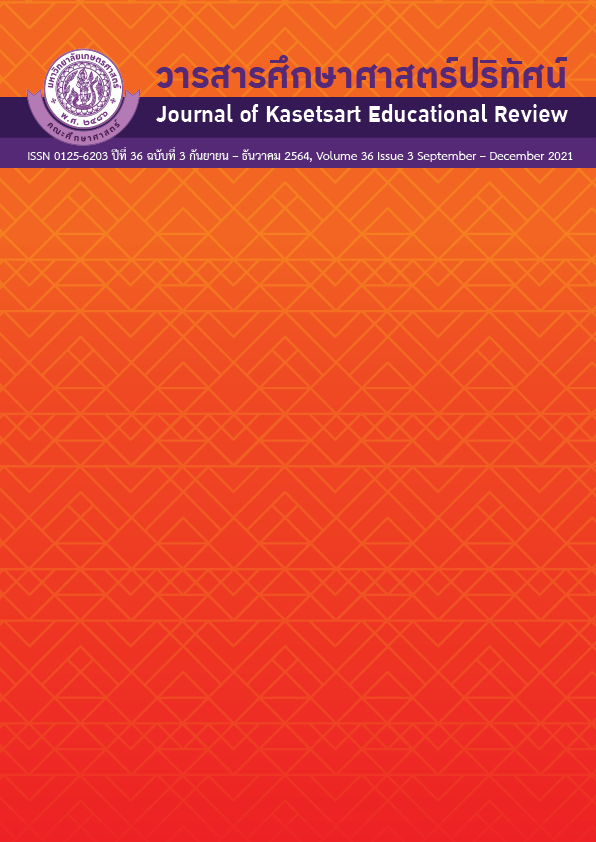การพัฒนาทักษะการแก้ปัญหาอย่างสร้างสรรค์ ในหน่วยการเรียนรู้ เรื่อง เซลล์และการทำงานของเซลล์ โดยการจัดการเรียนรู้ตามแนวสะตีมศึกษา
คำสำคัญ:
การแก้ปัญหาอย่างสร้างสรรค์, การจัดการเรียนรู้ตามแนวสะตีมศึกษาบทคัดย่อ
การวิจัยนี้เป็นการวิจัยเชิงปฏิบัติการในชั้นเรียน มีวัตถุประสงค์เพื่อ 1) ระบุแนวปฏิบัติที่ดีในการจัด การเรียนรู้ตามแนวสะตีมศึกษา และ 2) พัฒนาทักษะการแก้ปัญหาอย่างสร้างสรรค์ของนักเรียน โดยใช้การจัด การเรียนรู้ตามแนวสะตีมศึกษา กลุ่มที่ศึกษาได้แก่ นักเรียนชั้นมัธยมศึกษาปีที่ 4 จำนวน 26 คน เก็บรวบรวมข้อมูลโดยใช้แบบประเมินชิ้นงานการแก้ปัญหาอย่างสร้างสรรค์ ใบกิจกรรม บันทึกหลังการจัดการเรียนรู้ บันทึก การสังเกตของครูพี่เลี้ยงหรืออาจารย์นิเทศก์ และอนุทินของนักเรียน วิเคราะห์ข้อมูลเชิงปริมาณด้วยการหาค่าเฉลี่ย และวิเคราะห์ข้อมูลเชิงคุณภาพด้วยการวิเคราะห์ข้อมูลแบบอุปนัย ผลการวิจัยพบว่าแนวปฏิบัติที่ดีในการจัดการเรียนรู้ตามแนวสะตีมศึกษา ได้แก่ 1) การใช้สถานการณ์ปัญหาที่มี ความใกล้ตัวและเชื่อมโยงกับชีวิตประจำวันของนักเรียน 2) ขั้นประยุกต์ของการจัดการเรียนรู้ตามแนวสะตีมศึกษา ควรกำหนดระยะเวลาที่เหมาะสมเพียงพอและ จัดสมาชิกภายในกลุ่มของนักเรียนให้มีความคุ้นเคยกัน และ 3) การใช้ข้อคำถามใน ใบกิจกรรมที่ละเอียดและครอบคลุมสถานการณ์ปัญหา นอกจากนี้ผลการวิจัยพบว่าภายหลังการจัดการเรียนรู้ตามแนวสะตีมศึกษา นักเรียนมีทักษะของกระบวนการแก้ปัญหาอย่างสร้างสรรค์ในขั้นที่ 1 ขั้นทำความเข้าใจปัญหามากเป็นอันดับหนึ่ง มีค่าเฉลี่ยเท่ากับ 3.8 ซึ่งผลที่ได้จากงานวิจัยนี้สามารถนำไปใช้เป็นแนวทางสำหรับครูในการพัฒนารูปแบบการจัด การเรียนรู้ เพื่อพัฒนาทักษะการแก้ปัญหาอย่างสร้างสรรค์ให้เกิดขึ้นกับนักเรียนอย่างมีประสิทธิภาพต่อไป
เอกสารอ้างอิง
Arbesman, M. & Puccio, G. (2001) Enhanced Quality through Creative Problem Solving. Journal of Nursing Administration, 31, 176-178.
D’Zurilla, T.J. & Goldfried, M.R. (1971) Problem-Solving and Behavior Modification. Journal of Abnormal Psychology, 78, 107-126.
Ge, X., Ifenthaler, D. & Spector, J.M. (2015). Emerging Technologies for STEAM Education: Full STEAM Ahead. New York: Springer.
Isaksen, S.G., Dorval, K.B. & Treffinger, D.J. (2011). Creative Approaches to Problem Solving. 3rd ed. Thousand Oaks, CA: Sage Publications.
KambhunaAyudhaya, P. (2017). A Study on Creative Problem Solving and Creativity in Gifted Children in Fourth-Sixth Grade. Journal of Education Research Faculty of Education, Srinakharinwirot University, 11(2), 123-136. [in Thai]
Kemmis, S. & McTaggart, R. (1998). The Action Research Planner. Geelong, Victoria: Deakin University Press.
Lumsdaine, E. & Lumsdaine, M. (1995). Creative Problem Solving: Thinking Skills for A Changing Word. New York: McGraw-Hill.
Osborn, A. (1953). Applied Imagination: Principles and Procedures of Creative Problem Solving. New York: Charles Scribner's Sons.
Partnership for 21st Century Skills. (2007). Beyond the Three Rs: Voter Attitudes Toward 21st Century Skills. Tucson, AZ: Author.
Pintanasuwan, C. (2013). Effects of E-Learning by Using Inquiry Based Learning for Creative Problem Solving of Teaching Profession, Undergraduate Students (Master of Education Program in Educational Technology). Nakhon Pathom: Silpakorn University. [in Thai]
Riley, S. (2016). 6 Steps To Creating a STEAM-Centered Classroom. Retrieved from http:www.educationcloset.com/steps-to-creating-a-steam-centered-classroom/,
February 6, 2019. [in Thai]
Wiboonat, T. (2015). Comparisons of Creative Problem Solving and Learning Achievement of Mattayomsueksa 5 Students Who Learned Using the Problem-Based Learning with Project-Based Learning and Conventional Learning Approach. Journal of Education, Mahasarakham University, 9(3), 42-53. [in Thai]
ดาวน์โหลด
เผยแพร่แล้ว
ฉบับ
ประเภทบทความ
สัญญาอนุญาต
ลิขสิทธิ์ (c) 2020 วารสารศึกษาศาสตร์ปริทัศน์

อนุญาตภายใต้เงื่อนไข Creative Commons Attribution-NonCommercial-NoDerivatives 4.0 International License.
บทความทุกบทความเป็นลิขสิทธิ์ของวารสารคณะศึกษาศาสตร์ มหาวิทยาลัยเกษตรศาสตร์ วิทยาเขตบางเขน
วารสารศึกษาศาสตร์ปริทัศน์ (Kasetsart Educational Review)






